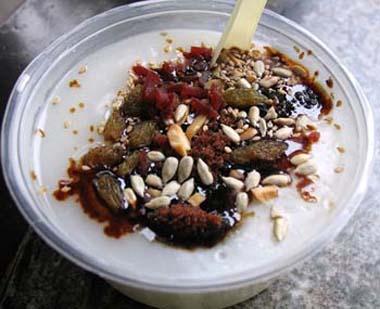Source:
02-26-2009 14:13
Snacks of Beijing can fall into three varieties: Han, Hui and imperial snacks, which are generally prepared by steaming, deep frying, frying in shallow oil, and instant boiling. Some people regard snacks of Beijing as "living fossils." Now snack restaurants can be found all over Beijing, such as Longfusi and Huguosi snack counters. Quick boiled Tripe Man, Chatang Li and Wonton Hou.
Chatang
Chatang or seasoned flour mush is a traditional gruel common to both Beijing cuisine and Tianjin cuisine, and often sold as a snack on the street. It is made from sorghum flour and/or broomcorn millet and/or proso millet flour and glutinous millet flour. The literal translation of the Chinese name is misleading, because there is neither any tea nor any soup in this dish.
 |
The dish is prepared in two steps. First, flours of sorghum and/or millet are cooked in advance, often stir fried, and after the completion, the flour is ready to be served. When a customer orders the dish, hot water is poured into the bowl containing the flour(s) to create a paste-like mush, and it is served with white and/or brown sugar, and Sweet Osmanthus sauce. Interestingly, the Sweet Osmanthus plant is not native to northern China.
Traditionally, the skill of the server judged on several factors and one of them is the requirement is regarding the resulting mush: the most skillful server would be able to create the mush that is so thick that when a chopstick is inserted into the mush, it remains vertical, while at the same time the mush remains fluid. Other criteria for the servers' skills included the ability not splash any hot water outside the bowl and spill out any flours, because traditionally all ingredients are placed in a bowl, into which is poured boiling water from a special copper kettle with a long, dragon-shaped spout. And special skills were needed to handle this equipment. The ingredients are then stirred together and the chatang is eaten with a spoon.
